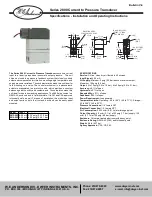
Model menu
Collective pitch curve
F X - 4 0
A typical curve for
the ‘Auto-rotation’
flight mode; the
base curve is a
linear type. For a
‘HOLD’ curve the
motor is cut or
moved to the Idle
position - see
‘Auto-rotation’
menu (Section 19.4). The bottom collective pitch value has
been reduced in order to maintain as high a rotor speed as
possible as the helicopter falls. The maximum value has
been increased to enable the model to flare out as smoothly
as possible with a high collective pitch angle, and land
safely. For most applications a three-point curve is suffi-
cient.
All these curves are only a guide; for every individual model
you will need to adjust and optimise the settings through a
programme of test-flying.
• Collective pitch settings
A separate frame is provided in which you can set the
speed and mode of the collective pitch servos. The linear
mode is used for controlling non self-neutralising functions,
whereas symmetrical mode is intended for self-neutralising
functions. A transit speed can be entered separately for
both directions of running, i.e. ‘there’ and ‘back’. The
adjustment range is 0 to 27 increments: the higher the num-
ber, the more slowly the servo moves. The maximum delay
time (27 increments) corresponds to a servo transit time of
nine seconds. The settings are changed using the arrow
buttons. The default setting is always ‘0’; pressing the
‘Reset’ button restores the default setting.
• Trimming the collective pitch function
The collective pitch trim can be optimised using the ‘Trim’
switch field, which is located at the left of the bottom line.
Mark the field, and the display changes to look like this, e.g.
for the ‘Hover’ flight mode:
The first step is to activate this option in the standard
fashion: simply mark the Status field, and the label in the
field changes from ‘INA’ to ‘ON’. After this you can deter-
mine whether the settings are to apply to all flight modes
(Glob) or only to the currently activated flight mode (Sepa).
Next you define the collective pitch trim mode in the
‘MODE’ field. The options here are ‘NORM’ and ‘CTRM’.
With the Normal trim type the trim range lies symmetrically
around the centre position, and the servo end-points are
affected when the trim value is changed. The Centre trim
type also works around the centre position of the transmit-
ter control, but does not affect the end-points, i.e. the trim
travels become asymmetrical. You can switch trim mode by
marking the appropriate field.
It is also possible to adjust the trim rate (Rate), or trim travel.
The adjustment range is infinitely variable between 0 and
30% of transmitter control travel; the default setting is 30%.
Mark this option, and use the arrow buttons to set your pre-
ferred percentage value. Pressing the ‘Reset’ button resto-
res the default setting. The direction of effect is defined by
the prefix in the adjacent field. The prefix changes every
time you mark the field.
You can also define the trim range (Range) as a percentage
value using the arrow buttons. If a small range is selected,
the trim only works around the centre position of the trans-
mitter stick. The adjustment range is 0% to 100%. The
default setting is 0%; pressing the ‘Reset’ button restores
the default setting.
The last step at this stage is to define a transmitter control
for varying the trim. Marking the ‘Transmitter control’ field
calls up the transmitter control select menu; you can now
select your preferred transmitter control using the proce-
dure already described many times.
A separate field is provided in which you can enter the trims
for ‘Collective pitch minimum’ and ‘Collective pitch maxi-
mum’ as the end-points of the collective pitch servos. The
programming procedure is exactly the same as that for defi-
ning the hover trim pre-sets, although in this case the trim
mode and trim range are not variable.
The screen shot above shows a typical example of pro-
gramming the ‘Collective pitch trim’ function.
• Entering the collective pitch angle settings
The values for maximum, minimum and centre collective
pitch angle can be set in the button field marked ‘Angle’.
Mark the field, and the screen looks like this:
The adjustment range is -30.0° to +30.0° for the maximum,
minimum and centre collective pitch angles; the default in
each case is 0.0°. You can change the settings using the
arrow buttons, but you must remember to move the collec-
tive pitch stick to the appropriate position first, otherwise
you will hear an audible warning signal.
The ‘Display’ switch field is used to define which of the pro-
grammed collective pitch curves is to be shown in the graphic
display, or which combination of curves. The options are as
follows:
85
















































